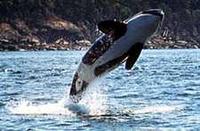Killer Whale
KILLER WHALE (Orcinus orca), also known as orca or blackfish, is the largest member of the DOLPHIN family of WHALES. Males and females are white and black in colour. The adult male grows to 7 tonnes and to 10 m in length; it has the tall, pointed dorsal fin that distinguishes the species. Killer whales are very sociable, living together in groups of related individuals called pods. There are 3 known "types" in BC waters. The most common, known as residents, travel in larger groups and eat fish. The second type, known as transient whales, travel in smaller groups; they range more widely and sometimes attack and eat other marine mammals, giving rise to the name killer whale. The third type, known as offshores, live in larger groups much farther away from the coastline and are believed to eat fish. The BC coast is home to 300 resident killer whales, about 220 transients and at least 200 offshores. The resident population is considered to be threatened, as is the northeast Pacific offshore population.
The first live killer whale was captured by the VANCOUVER AQUARIUM in 1964. Named Moby Doll, it survived almost 3 months and became a "goodwill ambassador" for killer whales, which had previously been feared and detested as vicious predators. Public opinion changed quickly, and commercial fishers began netting the animals to supply aquariums and theme parks around the world. At the end of the 1990s, one killer whale, Bjossa, was on display at the Vancouver Aquarium (a second, Finna, died in 1997); in 2000, Bjossa was moved to another facility.
In 1971 scientists using cameras and underwater microphones began to study BC killer whales, compiling a census of the local population and learning a good deal about their social organization and means of communication. Today the animals in JOHNSTONE and GEORGIA straits are the focus of a booming WHALE WATCHING industry. ROBSON BIGHT, a favourite resort of the killer whales, was made a marine ECOLOGICAL RESERVE in 1982, now called the Robson Bight (Michael BIGG) Ecological Reserve, after a pioneer of killer whale study in the province.


